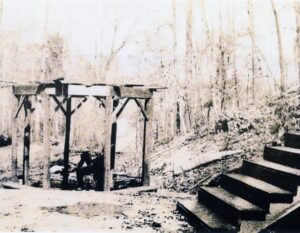When I was a kid, my grandfather would drink glass after glass of water he’d collect from an artesian mineral spring at his family’s old homeplace in rural Mississippi. He consistently touted its distinct, slightly salty taste and its ability to boost wellness. I wasn’t impressed. Stained a rusty brown by its mineral content, it didn’t look like water to me. (And since when was water supposed to have a flavor?)
My mom bought his sales pitch and asked him to bring her gallon jugs of the elixir every time he visited us in Alabama. I was in high school before I finally gave it a try, but once I got past the color, I was hooked. I don’t have any idea what was in it and even less of a clue if tales of its purported benefits held any water, but it was crisp and refreshing, and while it could have been my grandad’s faith spilling into me for a full-fledged placebo effect, I always felt revitalized after I drank it.
But my grandfather wasn’t alone in his claims. For hundreds of years, plenty of people have believed either bathing in or drinking (or both) natural mineral spring waters could treat all sorts of ailments from skin problems and indigestion to kidney disease and even cancer. While it didn’t cure his polio, the bubbling heated waters at Warm Springs in Georgia eased President Franklin D. Roosevelt’s symptoms. Most of the visitors to Hot Springs, Arkansas, in the early 20th century, were there to soak in tubs at the massive (and lovely) bathhouses that harnessed the flow of the area’s thermal springs. (Today, folks still visit the historic bathhouses and stop at fountains around the city, fill containers, and take the water home.)

(Alabama Mineral Springs/Contributed)
History of Alabama Mineral Springs
And our state is home to Alabama Mineral Springs. First discovered in Chilton County in 1889, the artesian spring originating in an aquifer approximately 215 feet underground, it inspired the construction of a health retreat and resort in the early 1900s, and in 1908, it was opened to the public. They came for the water, but the pastoral landscape and quaint cottages encouraged them to stay, while new-fangled technology like telephone lines made it all seem quite modern. In the early and mid-1930s, the springs’ curative properties were heavily promoted in newspaper ads. Folks from all over flocked to the spot, paying $1 a day to “take its waters.”
It grew in popularity and scope, and in 1939, a doctor took over the property. He expanded accommodations and amenities, adding more cabins and a swimming pool, plus electricity, to keep up with changing times. The actual mineral spring was encased in concrete for easier access as word of the resort’s relaxation and the springs’ vitality-reviving powers spread. By mid-century, a doctor, a specialist in herbal medicine, and a chiropractor were all onsite at Mineral Springs, creating a one-stop shop for improved health.

(Alabama Mineral Springs/Contributed)
A New Era
From 1954 on, the property bounced from one owner to another. It once served as a boys’ home operated by the Alabama Department of Youth Services. Eventually, it was abandoned, fell into disrepair, and faded from most memories. But even after nature took back the buildings, anyone who happened upon the land would have been treated to the soothing sound and sight of the springs still sparkling and streaming up from below, pumping out about 16 gallons a minute.
Its new owners, Marty Malizio, his wife Kay, and their business partner Diana Windsor, are once again capturing the pristine H2O bubbling out of the spring’s fountainhead, bottling it at the source and launching it as Simply Artesian Spring Water in June, after years of tearing down the dilapidated and vine-covered structures, having the mineral spring water quality tested—it passed with flying colors—and building a new production facility.

(Alabama Mineral Springs/Contributed)
They’re betting folks today will be just as entranced by the water’s taste as the many who’ve sipped (or chugged) it throughout its deep history. “It’s purely refreshing. That’s the tagline, but it is true,” says Marty. “It’s very light; there’s no bite or salty aftertaste that some mineral waters have.” Early testimonials call the imbibing experience “smooth and clean.” A water sommelier (yes, that’s a thing) notes, “It’s soft and creamy on the palate.” And, it’s clear, thanks to filtration that removes the iron and manganese that gives many mineral-rich waters their often-off-putting orange hue.
Healing Properties
Marty also points to its health benefits, stopping short of some of the “healing” promises made about the water in the past. “When we sent it off to be tested, we found out it contains six of the seven naturally occurring electrolytes [it’s only missing potassium], as well as silica, which is good for you, too,” he says. These electrically charged minerals—sodium, magnesium, potassium, calcium, chloride, phosphorus, and bicarbonate—enhance hydration, help regulate blood pressure and pH, support cardiovascular and muscular functions, aid in the conversion of nutrients to energy, and more.
“Proper hydration in general is essential for good health, and you can quench your thirst with any water,” Marty says, “but the addition of the minerals in our water is a bonus. We really believe our water is going to wow people.”




